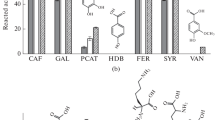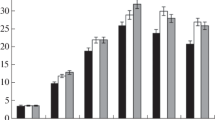Abstract
A synthetic fluorinated humic acid (FHA) was prepared by the spontaneous oxidative polymerization of 3-fluorocatechol. The 13C-solid-state NMR spectrum showed signals in the region for aromatic carbons with different substituents (aryl-H, aryl-C, aryl-O carbons) and for carboxyl-carbon. The latter indicated the formation of carboxylic groups, probably caused by ring cleavages during the polymerization process. An indication of the formation of carboxylic groups was also found in the infrared spectrum (band at 1715 cm−1). The dissolved FHA was degraded with active mycelium of the agaric white-rot fungus Nematoloma frowardii as well as with its isolated manganese peroxidase. In both cases, decolorization of the brownish FHA solution and partial defluorination (45–60%) took place. Degradation proceeded via formation of lower-molecular-mass fulvic acid-like substances. The results demonstrate that halogenated humic substances, e.g., resulting from the humification of xenobiotic compounds (bound residues), can in principle be eliminated by ligninolytic fungi (e.g., soil colonizing litter decomposers) and their manganese peroxidase system.
Similar content being viewed by others
Author information
Authors and Affiliations
Additional information
Received: 28 June 1999 / Received revision: 14 October 1999 / Accepted: 16 October 1999
Rights and permissions
About this article
Cite this article
Wunderwald, U., Kreisel, G., Braun, M. et al. Formation and degradation of a synthetic humic acid derived from 3-fluorocatechol. Appl Microbiol Biotechnol 53, 441–446 (2000). https://doi.org/10.1007/s002530051639
Issue Date:
DOI: https://doi.org/10.1007/s002530051639




